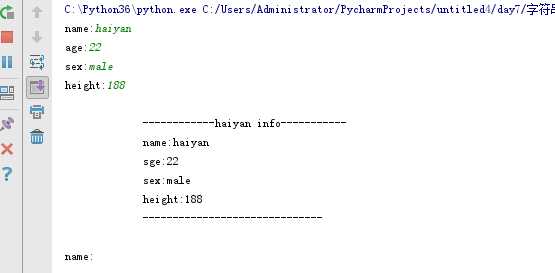
|
1
2
3
4
5
6
7
8
9
10
11
12
13
14
15
16
17
18
19
20
21
22
23
24
25
26
27
28
29
30
31
32
33
34
35
36
37
38
39
40
41
42
43
44
45
46
47
48
49
50
51
52
53
54
55
56
57
58
59
60
61
62
63
64
65
66
67
68
69
70
71
72
73
74
75
76
77
78
79
80
81
82
83
84
85
86
87
88
89
90
91
92
93
94
95
96
97
98
99
100
101
102
103
104
105
106
107
108
109
110
111
112
113
114
115
116
117
118
119
120
121
122
123
124
125
126
127
128
129
130
131
132
133
134
135
136
137
138
139
140
141
142
143
144
145
146
147
148
149
150
151
152
153
154
155
156
157
158
159
160
161
162
163
164
165
166
167
168
169
170
171
172
173
174
175
176
177
178
179
180
181
182
183
184
185
186
187
188
189
190
191
192
193
194
195
196
197
198
199
200
201
202
203
204
205
|
# name=‘egon‘ #name=str(‘egon‘)# print(type(name))#优先掌握#1.移除空白strip# msg=‘ hello ‘# print(msg)# print(msg.strip())# 移除‘*’# msg=‘***hello*********‘# msg=msg.strip(‘*‘)# print(msg)#移除左边的# print(msg.lstrip(‘*‘))#移除右边的# print(msg.rstrip(‘*‘))#用处while True: name=input(‘user: ‘).strip() password=input(‘password: ‘).strip() if name == ‘egon‘ and password == ‘123‘: print(‘login successfull‘)#切分split# info=‘root:x:0:0::/root:/bin/bash‘# print(info[0]+info[1]+info[2]+info[3])# user_l=info.split(‘:‘)# print(user_l[0])# msg=‘hello world egon say hahah‘# print(msg.split()) #默认以空格作为分隔符#cmd=‘download|xhp.mov|3000‘# cmd_l=cmd.split(‘|‘)# print(cmd_l[1])# print(cmd_l[0])# print(cmd.split(‘|‘,1))#用处while True: cmd=input(‘>>: ‘).strip() if len(cmd) == 0:continue cmd_l=cmd.split() print(‘命令是:%s 命令的参数是:%s‘ %(cmd_l[0],cmd_l[1]))#长度len# print(len(‘hell 123‘))#索引# 切片:切出子字符串# msg=‘hello world‘# print(msg[1:3]) #1 2# print(msg[1:4]) #1 2 3# 掌握部分oldboy_age=84while True: age=input(‘>>: ‘).strip() if len(age) == 0: continue if age.isdigit(): age=int(age) else: print(‘must be int‘)#startswith,endswith# name=‘alex_SB‘# print(name.endswith(‘SB‘))# print(name.startswith(‘alex‘))#replace# name=‘alex say :i have one tesla,my name is alex‘# print(name.replace(‘alex‘,‘SB‘,1))# print(‘my name is %s my age is %s my sex is %s‘ %(‘egon‘,18,‘male‘))# print(‘my name is {} my age is {} my sex is {}‘.format(‘egon‘,18,‘male‘))# print(‘my name is {0} my age is {1} my sex is {0}:{2}‘.format(‘egon‘,18,‘male‘))# print(‘my name is {name} my age is {age} my sex is {sex}‘.format(# sex=‘male‘,# age=18,# name=‘egon‘))# name=‘goee say hello‘# # print(name.find(‘S‘,1,3)) #顾头不顾尾,找不到则返回-1不会报错,找到了则显示索引# # print(name.index(‘S‘)) #同上,但是找不到会报错## print(name.count(‘S‘,1,5)) #顾头不顾尾,如果不指定范围则查找所有#join# info=‘root:x:0:0::/root:/bin/bash‘# print(info.split(‘:‘))# l=[‘root‘, ‘x‘, ‘0‘, ‘0‘, ‘‘, ‘/root‘, ‘/bin/bash‘]# print(‘:‘.join(l))#lower,upper# name=‘eGon‘# print(name.lower())# print(name.upper())#了解部分#expandtabs# name=‘egon\thello‘# print(name)# print(name.expandtabs(1))#center,ljust,rjust,zfill# name=‘egon‘# # print(name.center(30,‘-‘))# print(name.ljust(30,‘*‘))# print(name.rjust(30,‘*‘))# print(name.zfill(50)) #用0填充#captalize,swapcase,title# name=‘eGon‘# print(name.capitalize()) #首字母大写,其余部分小写# print(name.swapcase()) #大小写翻转# msg=‘egon say hi‘# print(msg.title()) #每个单词的首字母大写#在python3中num0=‘4‘num1=b‘4‘ #bytesnum2=u‘4‘ #unicode,python3中无需加u就是unicodenum3=‘四‘ #中文数字num4=‘Ⅳ‘ #罗马数字#isdigt:str,bytes,unicode# print(num0.isdigit())# print(num1.isdigit())# print(num2.isdigit())# print(num3.isdigit())# print(num4.isdigit())#isdecimal:str,unicode# num0=‘4‘# num1=b‘4‘ #bytes# num2=u‘4‘ #unicode,python3中无需加u就是unicode# num3=‘四‘ #中文数字# num4=‘Ⅳ‘ #罗马数字# print(num0.isdecimal())# # print(num1.)# print(num2.isdecimal())# print(num3.isdecimal())# print(num4.isdecimal())#isnumeric:str,unicode,中文,罗马# num0=‘4‘# num1=b‘4‘ #bytes# num2=u‘4‘ #unicode,python3中无需加u就是unicode# num3=‘四‘ #中文数字# num4=‘Ⅳ‘ #罗马数字## print(num0.isnumeric())# # print(num1)# print(num2.isnumeric())# print(num3.isnumeric())# print(num4.isnumeric())#is其他# name=‘egon123‘# print(name.isalnum()) #字符串由字母和数字组成# name=‘asdfasdfa sdf‘# print(name.isalpha()) #字符串只由字母组成## name=‘asdfor123‘# print(name.isidentifier())name=‘egGon‘print(name.islower())# print(name.isupper())# print(name.isspace())name=‘Egon say‘print(name.istitle()) |







昵称:
退出 订阅评论
[Ctrl+Enter快捷键提交]
【活动】华为云12.12会员节 云产品1折起 满额送Mate20 点击抢购
【推荐】服务器100%基准CPU性能,1核1G首年168元,限时特惠!
· 微软2018开源大事记
· 为了硬扛抖音,腾讯拉了100个短视频达人打群架
· 禁令之下交易仍很活跃 “呼死你”软件为何打不死?
· 百度无人车拿下天津首批路测牌照 获中国专利奖
· 天文学家与阿里寻找第二地球:39光年外或有生命条件
» 更多新闻...